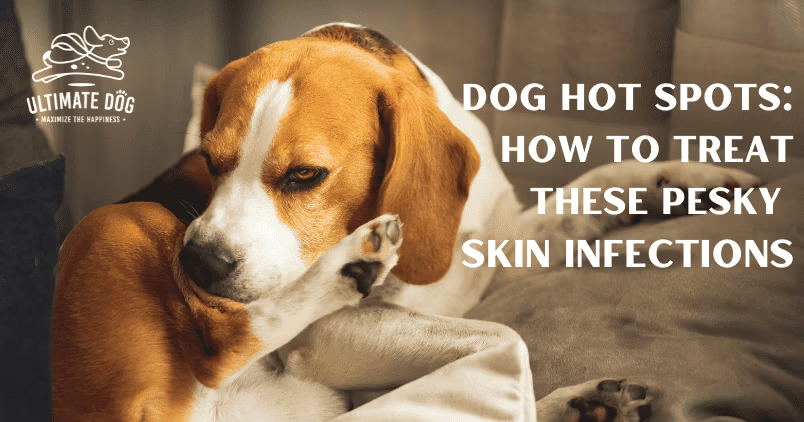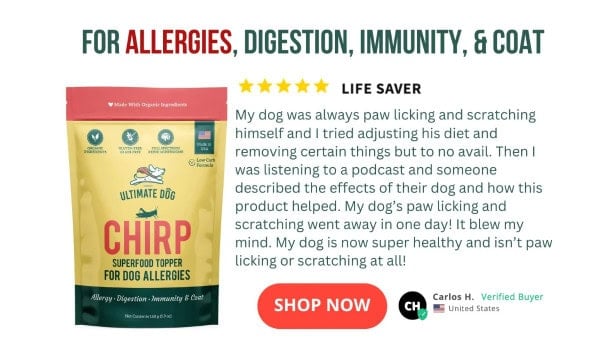They’re red, oozy, and painful. And worst of all, they can appear overnight and seemingly without cause. As much as we hate looking at hot spots, our pets likely hate suffering through them even more.
Luckily, there is something you can do. Not only are there a number of effective, natural hot spot treatments out there, but there are steps you can take to stop these terrible flare-ups before they start.
Below, you’ll find everything you need to know about hot spots on dogs. We’ll tell you what they are, what causes them, and how you can treat them. Most importantly, we’ll help you determine how to prevent hot spots so your dog can find lasting relief.
What Are Hot Spots?
Hot spots are inflamed areas of skin that appear bright red with oozing pus or wet discharge. The term actually covers multiple medical conditions, most commonly pyotraumatic dermatitis and acute moist dermatitis.
Pyotraumatic dermatitis refers to inflamed areas of skin caused by obsessive chewing or scratching. While these hot spots can become infected, the underlying cause usually has nothing to do with bacteria or infection, at least not of the skin.
Acute moist dermatitis refers to hot spots that are not caused by self-inflicted harm. Typically these spots arise when an underlying condition causes the skin to become inflamed.
Hot spots can appear anywhere on the body but are most common on the head, legs, and hips. All breeds are susceptible to the condition, though individuals with long coats tend to suffer from hot spots more often.
Hot Spot Causes
Identifying the cause of your dog’s hot spots isn’t always easy. This is in part because many things can cause inflammation in the skin and lead to the formation of an oozy, painful, red spot.
But determining the cause is important as hot spots often return and become chronic if the root of the problem is not addressed.
Allergies
Just like humans, dogs can have skin reactions when they encounter a protein they are allergic to or sensitive to. If the contact was isolated to one area of skin, the inflammation can quickly lead to the formation of a hot spot. Even if the reaction was more generalized, chewing and scratching in one or two focused areas can cause hot spots to develop.
Topical allergies are most likely to lead to hot spots, but food allergies and sensitivities can also cause inflammation in the skin. This is especially true if a dog is repeatedly exposed to an ingredient they are allergic to. The constant inflammation in the gut taxes the immune system and can cause it to become more reactive, both inside the body and in the skin.
If your dog suffers from repeat hot spots that tend to happen at the same time every year, this is a good sign they’re experiencing a topical allergy. If the hot spots are chronic and happen with the same frequency throughout the year, a food allergy may be to blame.
Flea Allergy Dermatitis
One of the most common topical allergies that causes hot spots is an allergy to flea saliva.
Flea allergy dermatitis occurs when a dog has an immune reaction to the bites of fleas. The skin becomes inflamed at the site of the bite which causes excess chewing and scratching that eventually forms a hot spot.
If there is evidence that your dog has fleas and you notice their hot spots tend to happen in summer, when flea infestations peak, that’s a good indicator fleas are your problem. It is especially likely if your dog was between the ages of 1 and 3 when the first incidence occurred.
Insect Bites
Even without an allergic reaction, insect bites can cause hot spots. Mosquitos, spiders, ants, and many other bugs have painful or irritating bites that leave the skin inflamed and itchy. If your dog spends too much time scratching or biting at the bite, it can turn into a hot spot.
If your dog suddenly develops a hot spot after spending time outdoors, a bug bite is likely to blame. In this case, the issue isn’t going to repeat itself unless the dog is spending a lot of time outdoors.
Injury
Sometimes, it isn’t the skin that’s inflamed, but the muscle or tendons underneath. When your dog has a painful injury such as a pulled muscle, fracture, or joint problem, they may lick the area in an attempt to make it feel better. If this licking becomes obsessive, a hot spot will form.
When an injury is the underlying problem, you’ll notice the hot spot form slowly. On lighter dogs, you may see stained red fur in the area—a sign your dog is licking the spot frequently. Over the course of a few days, continued licking will cause the hair to fall out and the skin to become red and inflamed.
You will also likely notice limping, stiffness, or other indicators of soreness in the area even before the hot spot forms.
Skin Infection
Pyoderma, or infections of the skin, can also cause hot spots. These infections can be from a number of sources, from yeast overgrowth to an embedded splinter. The infected area may grow into a hot spot on its own or with the help of obsessive licking and scratching from your dog.
In either case, the cause of the infection will need to be addressed before the hot spot will heal.
Ear infections can also cause hotspots as the dog attempts to soothe itself by scratching at the ear. When an ear infection is to blame, the hot spot typically forms on the outside of the ear flap or at the base of the ear.
Stress
Just as dogs use licking to soothe physical pain, they can also employ this method to soothe mental discomfort.
If your dog is bored or stressed, they may resort to licking themselves in order to produce soothing endorphins. When this behavior becomes obsessive and focused on one spot, it can quickly lead to the formation of a hot spot.
Dog Dermatitis
General dermatitis develops in dogs when the biome of the skin is thrown out of balance either by the environment, internal imbalance, or genetic factors.
Most commonly, dermatitis in dogs is caused by poor diet and/or poor grooming. Curly coated dogs especially are at risk of developing skin problems and hot spots if their coats become matted.
The skin is the largest organ in the body and thus requires a huge amount of protein and fat to function correctly. If your dog’s diet is lacking in either of these areas, the skin is the first place you’ll see signs. Dryness, itching, and hot spots that become chronic are good indicators your dog needs a better diet.
Chronic Hot Spots
For many dogs, hot spots occur chronically, meaning that they suffer from them over and over. Often, these chronic hot spots recur in the same area. But it’s also possible for recurring hot spots to appear on various parts of the body.
Chronic hot spots are often a sign of allergies, stress, or a poor diet.
Acute Hot Spots
Acute hot spots are those that appear suddenly but don’t necessarily come back once they are treated. These are typically a sign of an insect bite, injury, or acute skin infection.
So long as the underlying cause behind the hot spot is addressed fully, your dog will not likely have to deal with repeated hot spots.
Natural Hot Spot Treatments
Now that you have some insight into what may be causing your dog’s hot spots, it’s important to act to help address the root cause. But, in the meantime, you’ll also need to work to treat the hot spot your dog currently has.
Luckily, there are many accessible natural treatments that can help the hot spot heal without undoing any work you’ve put in to treat the underlying cause.
Herbal Rinses and Salves
There are many herbs out there known to ease inflammation and pain associated with skin infections and hot spots. Many of these can be made into teas and applied to the wound as a cool compress. Others can be made into a soothing salve.
In general, you want to use rinses and compresses early, when the hot spot is still oozing and moist. Once it’s healed and begun to dry, then you can switch to a slave.
Here are the best herbs to use for hot spots:
- Black Tea – Tannins in black tea relieve infection and will help dry out fresh hot spots.
- Calendula – Brew as a tea or buy as a salve to reduce itching and redness.
- Echinacea – Brew as a tea to promote healing and reduce infection, or buy as a powder, mix with 2x bentonite clay, and sprinkle on the hot spot. Let sit for 45 minutes, then rinse.
- St. John’s Wort – Mix tinctures with water for a pain-relieving, cleansing rinse, or add to calendula salve to promote healing.
- Witch Hazel – Buy witch hazel rinse and apply with a clean rag to dry out and calm fresh hot spots.
GAGs
Glycosaminoglycans (GAGs) are a type of polysaccharide that has been proven effective in the treatment of acute moist dermatitis. When given orally with sphingolipids, a unique class of fats, GAGs create a significant increase in polyunsaturated fatty acids in the skin.
The easiest way to get GAGs and polysaccharides to your dog is by giving a glucosamine and chondroitin supplement. These two molecules are present within these compounds. Choose a high concentrate product and give orally as directed to address issues with hot spots.
Omega 3 Fatty Acids
Adding a quality omega-3 fatty acid supplement to your dog’s routine is a great idea if they have skin issues of any kind. These lipids have proven effective in helping strengthen skin and prevent skin infections. They can also help hot spots heal faster.
Omega supplements for dogs can be found online or at your local pet supply store.
Colostrum
Colostrum has many benefits when used as a supplement, but it can also be quite helpful when used topically on hot spots. Colostrum has been shown to reduce inflammation, speed up healing, and prevent infection.
Make a paste using powdered colostrum and water and apply it to your dog’s hot spot daily.
Apple Cider Vinegar
Apple cider vinegar is loaded with probiotics that can help restore balance to unbalanced skin and encourage the healing of hotspots. The acid in the vinegar also helps prevent bacteria growth. Because vinegar can sting, wait until the wound has started to dry before applying.
For best results, use organic raw apple cider vinegar with the mother included.
Mix 1 part vinegar with 1 part water and spritz the wound or dab the mix on with a clean rag.
Acupuncture
One surprising treatment for hot spots that has proven impressively effective is acupuncture.
Studies have shown that acupuncture can exert anti-inflammatory effects on the skin. These effects work through a complex neuro-endocrino-immunological network by inhibiting histamines and down-regulating pro-inflammatory cytokines, neuropeptides, and neurotrophins.
For dogs experiencing chronic hot spots, this may be one avenue worth pursuing as you work to cure the underlying cause of the inflammation.
Laser Therapy
Laser therapy is another great option for dogs with a long history of hot spots. Wavelengths between 630nm (red) and 830nm (near-infrared) appear to be the most effective for promoting skin healing and rejuvenation.
Therapy should be started as soon as the hot spot forms to reduce inflammation, then continued until the area is fully healed.
Hyperbaric Oxygen Therapy
While not the most cost-effective method of treatment, hyperbaric oxygen therapy (HBOT) has the potential to be life-changing for dogs with chronic hot spot issues, especially if the condition is caused by immune dysregulation.
HBOT has proven highly effective in treating many inflammation-driven skin conditions and has been shown to exert immune regulatory effects on chronic skin ailments.
Probiotics
It’s not just the gut that has a biome made up of billions of helpful microbes. The skin has its own helpful biome that can easily be upset by stress and environmental factors.
By giving your dog a quality probiotic supplement, you can help their hot spots heal faster and prevent them from coming back. In addition to rebalancing the skin, probiotics can also help strengthen the immune system and prevent overreaction responses that lead to inflammation.
Antioxidants
Antioxidants and other flavonoids are vital to reducing inflammation in the body. They also have the potential to strengthen connective tissue and reduce allergic reactions.
By including an antioxidant supplement in your dog’s routine, you can help their body overcome many of the common stressors that lead to hotspots. Antioxidants can also be added to your dog’s diet by adding powdered berries, greens, reishi mushrooms, quercetin, or even cricket powder to their homemade or raw meat meals.
How to Prevent Hot Spots in Dogs
Many of the supplemental treatments above can be continued well after your dog’s hot spot has healed. Omega-3s, acupuncture, probiotics, antioxidants, and GAG supplements will help maintain balance and optimal health to prevent hot spots in the future.
It’s also important to feed your dog a high-protein diet with plenty of good fats to support skin health. Many commercial dry and wet food products are overloaded with carbohydrates and use low-quality protein sources. Switching to a raw or homemade high-meat diet can significantly help improve your dog’s health.
These kinds of diets also give you far more control over the ingredients your dog eats. This is key if your pet has allergies or sensitivities.
Beyond what goes into your dog, you also need to be aware of what goes on them and the health of their coat. Avoid overusing flea and tick treatments and be sure any shampoos you use are made for the specific pH of a dog’s skin. Avoid using antibacterial shampoos. Curly coated and long-haired dogs need to be brushed daily and groomed to keep their coats from matting.
Be sure to also work to control your dog’s environment to assure common causes of hot spots don’t cause your pup problems. This means wiping out flea infestations, giving your pup plenty of exercise and mental stimulation to control stress, and keeping them safe from the elements to avoid insect bites and topical allergens.
Help Your Pup Find Relief
When it comes to helping your dog find relief from hot spots, the first step is to figure out what is causing the problem. As you work to address the root of the inflamed skin, you can use many effective natural remedies to help heal any hot spots they already have.
Once the root has been addressed and all hot spots dealt with, be sure to provide a quality diet that includes probiotics and omegas, keep up with grooming, and work to control your pet’s environment to reduce their exposure to common causes of hot spots.
Sources
Dryden DVM, MS, M. W., & Blakemore DVM, J. C. (1989). A Review of Flea Allergy Dermatitis In the Dog and Cat. Companion Animal Practice, 19(June/July).
Koh, R. D. (2018, March 26). Integrative approach to skin problems in pets. IVC Journal.
M. (2021, October 12). Pyotraumatic dermatitis (acute moist dermatitis, hot spot). Veterinary Practice.
Marsella, R., & Friberg, C. (2017). Topical therapy for atopic dermatitis. A practical option? Are expectations met? Advances in Veterinary Dermatology, 220–223.

Sara Seitz worked in the pet industry for over a decade. In addition to being a certified dog trainer, Sara gained experience working as the general manager of a dog daycare and boarding facility, as the creator and manager of a pet sitting company, as a groomer, and as a dog behavior evaluator. She also has a bachelors in animal behavior from CSU. Currently, Sara works as a freelance writer specializing in blog, article and content writing.




Leave a Comment